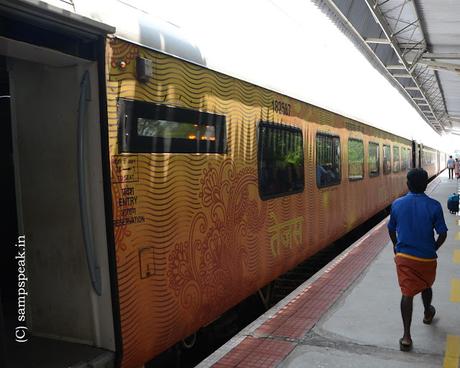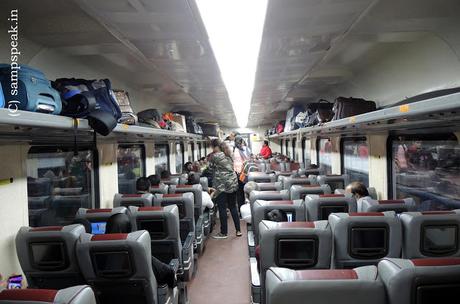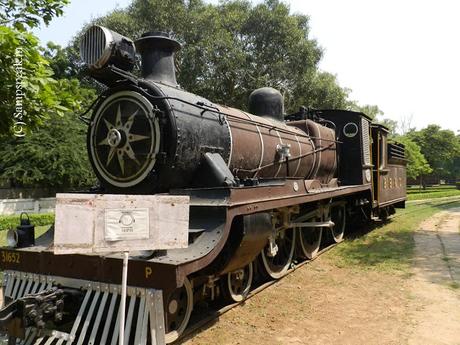A travel by train, especially, day travel is always exciting .. .. recently I traveled by Tejas Express, the super fast from Chennai Egmore to Madurai enjoying scenic Tamil Nadu through the wider windows of the train that has only 2 halts – Trichy Jn and Kodai Road... .. .. the class of Rail coaches has certainly changed.

 Soon, Indian
railways passengers will be able to travel in trains that are manufactured with
private sector world-class technology! With a strong emphasis on need for
private investment in Indian Railways, Finance Minister Mrs Nirmala Sitharaman
in her Railway Budget 2019 speech spoke of unleashing the PPP (Public-Private
Partnership) for faster development of railway infrastructure including rolling
stock. FM Sitharaman also stressed on how the Dedicated Freight Corridors will
decongest the railway network for faster movement of trains. She also said that
Special Purpose Vehicles (SPVs) will be encouraged for the suburban railway
network development.
Till
a decade or so ago, one of themost
sought after books was ‘Railway Guide’ – we used to glean through its pages
finding out the trains between stations, the departure timings, fares, railway
rules and more .. now a days, all information is available on a flick in a
smart mobile. Indian
Railways has released its new all India timetable known as “Trains at a Glance”
effectiveJuly 1 2019.In addition to this, all the 17 Zonal
Railways have also released their respective timetables.The new all India trains timetable is
available on Indian Railways’ official website - www.indianrailways.gov.in.
As
part of Mission Raftaar, 261 trains have been speeded up (by up to 110 minutes)
in different zonal Railways, thereby, providing a faster transit to the
passengers, a statement issued by the Ministry of Railways stated.One Vande Bharat
Express train, 34 Humsafar Express trains, 11 Antyodaya Express trains, 2 Tejas
Express trains, one Uday Express train have been incorporated in the new
timetable. "In addition, more than
34,200 Special train trips were run during 2018-19 to clear extra rush and meet
passenger demand, about 500 coaches were permanently augmented in about 300
trains to increase the carrying capacity," the statement said.
The ‘Make in India’ Train 18, Vande Bharat
Express has been a big technological leap for the Indian railways, ushering it
into the era of self-propelled semi-high speed travel on world-class train
sets. Vande Bharat Express has resulted in the reduction of travel time between
New Delhi and Varanasi by about 40%. Considering its success, Indian Railways
is looking to proliferate manufacturing of such train sets with aim to
introduce a Rajdhani-style sleeper version as well. The Vande Bharat Express
boasts several interesting features like on-board hotspot WiFi, automatic
doors, GPS-based audio-visual passenger information system, bio-vacuum type
toilets, etc. The Railway Ministry is currently trying to identify more routes
for this train service. Humsafar Express: is an all AC-3 tier train with 22
coaches aimed at giving a taste of
‘luxury’ to the common man. In a bid to
improve the quality of travel for unreserved passengers, Indian Railways
introduced the superfast train- Antyodaya Express. The train consists of 22
coaches, out of which 20 are general coaches, while the rest 2 are power cars. Mail/Express trains have been equipped with
‘Deen Dayalu’ coaches.
For
the regular Quiz Q on when was the first train run in India – the customary
answer would be :3:35pm on April 16th , 1853, when a train with 14
railway carriages and 400 guests left Bombay's BoriBunder for Thane, with a 21-gun
salute. It was hauled by three locomotives: Sindh, Sultan, and Sahib. The
journey took an hour and fifteen minutes.That, however, was just the first commercial passenger service in India.
In fact, a few other railways are known to have operated in India prior to
1853, for hauling materials.In 1835, a short experimental line was laid near
Chintadripet. In 1845, a railway was built for carriage of stone and
construction materials for irrigation works and a dam over the Godavari near
Rajahmundry.
Soon, Indian
railways passengers will be able to travel in trains that are manufactured with
private sector world-class technology! With a strong emphasis on need for
private investment in Indian Railways, Finance Minister Mrs Nirmala Sitharaman
in her Railway Budget 2019 speech spoke of unleashing the PPP (Public-Private
Partnership) for faster development of railway infrastructure including rolling
stock. FM Sitharaman also stressed on how the Dedicated Freight Corridors will
decongest the railway network for faster movement of trains. She also said that
Special Purpose Vehicles (SPVs) will be encouraged for the suburban railway
network development.
Till
a decade or so ago, one of themost
sought after books was ‘Railway Guide’ – we used to glean through its pages
finding out the trains between stations, the departure timings, fares, railway
rules and more .. now a days, all information is available on a flick in a
smart mobile. Indian
Railways has released its new all India timetable known as “Trains at a Glance”
effectiveJuly 1 2019.In addition to this, all the 17 Zonal
Railways have also released their respective timetables.The new all India trains timetable is
available on Indian Railways’ official website - www.indianrailways.gov.in.
As
part of Mission Raftaar, 261 trains have been speeded up (by up to 110 minutes)
in different zonal Railways, thereby, providing a faster transit to the
passengers, a statement issued by the Ministry of Railways stated.One Vande Bharat
Express train, 34 Humsafar Express trains, 11 Antyodaya Express trains, 2 Tejas
Express trains, one Uday Express train have been incorporated in the new
timetable. "In addition, more than
34,200 Special train trips were run during 2018-19 to clear extra rush and meet
passenger demand, about 500 coaches were permanently augmented in about 300
trains to increase the carrying capacity," the statement said.
The ‘Make in India’ Train 18, Vande Bharat
Express has been a big technological leap for the Indian railways, ushering it
into the era of self-propelled semi-high speed travel on world-class train
sets. Vande Bharat Express has resulted in the reduction of travel time between
New Delhi and Varanasi by about 40%. Considering its success, Indian Railways
is looking to proliferate manufacturing of such train sets with aim to
introduce a Rajdhani-style sleeper version as well. The Vande Bharat Express
boasts several interesting features like on-board hotspot WiFi, automatic
doors, GPS-based audio-visual passenger information system, bio-vacuum type
toilets, etc. The Railway Ministry is currently trying to identify more routes
for this train service. Humsafar Express: is an all AC-3 tier train with 22
coaches aimed at giving a taste of
‘luxury’ to the common man. In a bid to
improve the quality of travel for unreserved passengers, Indian Railways
introduced the superfast train- Antyodaya Express. The train consists of 22
coaches, out of which 20 are general coaches, while the rest 2 are power cars. Mail/Express trains have been equipped with
‘Deen Dayalu’ coaches.
For
the regular Quiz Q on when was the first train run in India – the customary
answer would be :3:35pm on April 16th , 1853, when a train with 14
railway carriages and 400 guests left Bombay's BoriBunder for Thane, with a 21-gun
salute. It was hauled by three locomotives: Sindh, Sultan, and Sahib. The
journey took an hour and fifteen minutes.That, however, was just the first commercial passenger service in India.
In fact, a few other railways are known to have operated in India prior to
1853, for hauling materials.In 1835, a short experimental line was laid near
Chintadripet. In 1845, a railway was built for carriage of stone and
construction materials for irrigation works and a dam over the Godavari near
Rajahmundry.

Between Dhaboi and Miyagam in Gujarat is an Indian Railways line which is also said to be Asia’s first narrow-gauge line. However, soon this narrow-gauge line will be converted to braod gauge, reports IE. The line which has been operational since 19th century, does not add to present railway requirements. Earlier this year, the Railway Board decided to preserve this line as an invaluable piece of industrial heritage. However, recently,the Western Railway, which has jurisdiction over this line, wrote to the Railway Board stating that the project for converting this narrow gauge line into broad gauge line and linking it to the main line was sanctioned in the year 2011-12, and the work for that has already started. Miles away, in 1865, Royal assent was given to an Act of Parliament allowing the Talyllyn Railway to carry passengers by steam haulage – the first narrow-gauge railway in Britain to do so from the start.The Talyllyn Railwayis a narrow gauge preserved railway in Wales running for 7 1⁄4 miles (12 km) from Tywyn[a] on the Mid-Wales coast to Nant Gwernol near the village of Abergynolwyn. The line was opened in 1865 to carry slate from the quarries at Bryn Eglwys to Tywyn, and was the first narrow gauge railway in Britain authorised by Act of Parliament to carry passengers using steam haulage. Years later, it was preserved and has been operated as a tourist attraction, expanding its rolling stock through acquisition and an engineering programme to build new locomotives and carriages. The railway opened with two locomotives, one carriage and several goods vehicles in use and was operated under a "one engine in steam" policy to ensure that two trains could not collide. The railway used steam locomotives from the start, unlike its neighbor the horse-drawn Corris Railway. The original two locomotives, although of entirely different design, were both purchased from Fletcher, Jennings & Co. of Whitehaven in Cumbria, and both are still in service, 150 years on, although so many of their parts have been replaced down the years that much of their present-day component metal is not original. Interesting ! With regards – S. Sampathkumar 6th July 2019.

